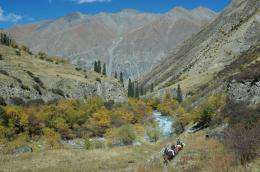'Like a jet through solid rock': Volcanic arc fed by rapid fluid pulses

In the depths of the earth, it is anything but peaceful: large quantities of liquids carve their way through the rock as fluids, causing magma to form. A research team led by the University of Münster, has shown that the fluids flow a lot faster through solid rock than previously assumed. In the Chinese Tian Shan Mountains, fluids pushed their way to the earth's mantle from great depths in just 200 years rather than in the course of tens or even hundreds of thousands of years.
The researchers from Münster, Kiel, Bochum, Erlangen, Bethlehem (USA) and Lausanne (Switzerland) present their findings, based on an innovative combination of fieldwork, geochemical analysis and numerical calculations, in the current issue of the journal Nature Geoscience. The RUB geoscientists are experts in determining time scales using numerical models.
When tectonic plates move towards each other and push over each other at the edges, so-called subduction zones are formed. The descending plate is heated and continuously releases the water stored in its rocks as fluid. The fluid penetrates the earth's mantle, which is located above the descending plate. The fluids thus lower the melting point of the mantle rocks, and the liquid rock formed rises to the volcanoes as magma. This magma feeds the many volcanoes throughout the world that occur along the convergent plate boundaries and form the "Ring of Fire", a volcanic belt that encircles the Pacific Ocean. The fluids are commonly assumed to flow through the rock in a defined flow system. Geologists call these structures veins.
During field work in the Chinese part of the Tian Shan Mountains (Celestial Mountains), the research team found structures in the rocks they were studying which can be ascribed to massive fluid flows at great depth. "Our investigation has shown that a great deal of fluid must have flowed through a rock vein at about 70 km depth and that this fluid has obviously already covered a distance of several hundred meters or more - the transport of such large quantities of fluid over such a great distance has not been demonstrated by anyone before us" explains Timm John from the Institute for Mineralogy, University of Münster. "And the most exciting thing is that this amount of fluid flowed through the rock in what is for geological processes a very short time, only about two hundred years", adds Nikolaus Gussone of the same institute.
The release of fluids from minerals in the descending plates is a large-scale and continuous process that takes place at depths up to two-hundred kilometres and takes millions of years. During this time, the fluids first accumulate. As the researchers have now shown for the first time, the released fluids then flowed through the plate on their way to the mantle in pulses in a relatively short time along defined flow paths. "It's like a reservoir that continuously fills and then empties in a surge through defined channels" Timm John points out. "The fluid release is focused in space and time, and is much faster than expected - almost like a jet through solid rock". The researchers hope to be able to show the spatial and temporal correlations between such fluid pulses and volcanic activity in future studies. It is also possible that such focused fluid releases are associated with the occurrence of earthquake events in subduction zones. To be able to demonstrate such relations, however, intensive research is still needed.
The RUB's petrologists were involved in modelling the chemical data. This enabled the research team to determine the time it took the fluids to make their way to the mantle. Determining the time scales of various geological processes is a particular expertise of Bochum's petrologists. Among other things, they use minerals and rocks with zones that exhibit a different chemical composition.
More information: T. John et al. (2012): Volcanic arcs fed by rapid pulsed fluid flow through subducting slabs. Nature Geoscience, doi: 10.1038/NGEO1482
Journal information: Nature Geoscience
Provided by Ruhr-Universitaet-Bochum















